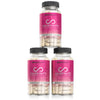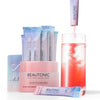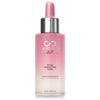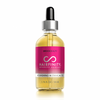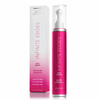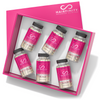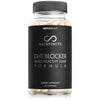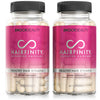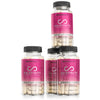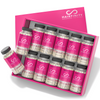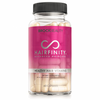
The Skinny on Sulfates: What You Need to Know to Protect Your Hair

If you’re worried about sulfates and all those unpronounceable ingredients on the back of your shampoo bottle, we’re here to shed a little light on what’s in your suds.
But understanding what’s in your shampoo is only the first step to getting clean, soft, and manageable hair.
Here’s everything you need to know about how to get squeaky clean – without irritating your sensitive scalp:
What’s In a Name? All About Sulfates

For the past ten years, conscious consumers have started to get wise to the beauty industry. They worry about parabens and phthalates and sulfates – but they might not know exactly why.
Wonder no more. Before you chuck all your shampoo straight in the garbage, we’re here t
o help you de-code some of those ingredients, starting with sulfates.
First things first: sulfates are surfactants, or the chemical compound that helps create lather in shampoo.
“This unique property allows soaps, shampoos, and body washes to separate dirt and oil from your skin or hair and then allow the water you rinse it with to carry it off your body and down the drain,” explains XOVain.com’s resident chemist, Kevin Ewell.
When they crop up in shampoos, sulfates come in the form of sodium laureth sulfate, sodium lauryl sulfate, or ammonium laureth sulfate. These compounds make shampoo lather bubbly and leave you with that squeaky-clean feeling.
While sulfates in and of themselves aren’t necessarily dangerous, they can be drying and irritating – especially if you have curly hair.
“Sodium lauryl sulfate, the key ingredient in most traditional shampoos, is both a salt and a detergent – an effective cleanser that’s too harsh for most curls,” writes Lexi Novak at Allure.
Using sulfate shampoo on curly, fine, or color-treated hair is likely to result in a dry, frizzy, irritated mess, since sulfates strip away natural oils – and moisture.
If this problem sounds familiar to you, you may want to steer clear of shampoos with sulfates. Curly-haired ladies already have enough trouble maintaining moisture as it is.
And while there are plenty of studies that show sulfates don’t cause cancer or other life-threatening illnesses, chemist Kevin Ewell points out that they are a known irritant.
“Get sulfate shampoo in your eyes and it will really sting,” said Ewell. Ouch.
There are plenty of reasons to be skeptical of the beauty and cosmetics industry, and lack of regulation and testing standards is certainly one of them. So if the chance of encountering sulfates in your shampoo freaks you out, we totally get it.
Thankfully, it is possible to avoid sulfates in shampoo altogether. Whether you’re allergic, sensitive, or just want to play it safe, here’s the 411 on going sulfate-free:
The Low-Down on Sulfate-Free Shampoo
Switching to sulfate-free shampoo has never been easier. There are more options on the market, and plenty of good reasons to try out a product with fewer chemicals.
“I think there are so many chemicals in our personal hygiene products, foods and environment that people have become more aware and rightly concerned,” dermatologist Rebecca Baxt explained to Huffington Post.
“Anything with fewer chemicals has become more popular,” she added, referring to the number of sulfate-free shampoos available.

Since sulfates are the primary ingredient responsible for shampoo lather, you can expect a less bubbly experience in the shower, says cosmetic chemist Ni’Kita Wilson.
“Sulfate-free systems are more difficult to thicken, which means that chemists have to add more ingredients to make a nice product,” Wilson told Women’s Health. “Otherwise your shampoo would flow like water.”
If you’re allergic to sulfates or they dry out your scalp, you should start to notice a difference right away with your new shampoo.
Your hair will be softer, retaining more of its natural oils between washes. Your scalp should feel calmer, too, since sulfates can actually lift up the hair’s cuticle as they clean, leading to dryness and irritation.
Shopping around for a sulfate-free shampoo? You should look for “mild detergents that don’t completely wash away your hair’s moisture,” writes Alessandra Foresto at Women’s Health.
“They have names that are a mouthful and sound similar to sulfates, like sodium lauryl sulfoacetate,” she adds. (Gesundheit!)
When it comes down to it, choosing to go sulfate-free is a personal choice – every woman has totally different needs based on her hair type, says Foresto.
“Those with parched or color-treated hair may benefit from using a gentler cleansing choice to prevent their hair from feeling super dry,” she writes, “while those who have greasier strands will probably find that they need to use sulfates to truly feel like their hair is clean.”
If you want to check out sulfate-free shampoos and need a few ideas about where to start, here are a few great options from StyleCaster and InStyle to help you in your quest for clean (but well-moisturized!) hair.
A Better Shower
When it comes to lathering up (or not lathering up, as the sulfate-free case might be), shampooing is only half the battle.
Most people actually shampoo way too often, says health writer Nick Burns, drying out their hair and irritating their scalp in the process.
“Washing daily with any shampoo, even with the low-sulfate kind, will strip some oil and dry your hair and scalp,” writes Burns at Men’s Journal.
“What’s more, most styling products like gel and hairspray are water-soluble, so they don’t need shampoo to rinse out of hair,” he adds.

Whether or not you make the switch to sulfate-free shampoo, most experts recommend scaling back on shampoo use for healthier hair – especially if you regularly combat dryness.
You only need to shampoo once or twice a week – even less if you plan to co-wash your hair with conditioner. This way, you retain natural oils and sebum that will moisturize both your scalp and your hair.
Co-washing can help you keep your scalp clean without the drying effect of shampoo and is especially helpful for women who have transitioned from relaxed to natural hair.
“Most conditioners contain trace amounts of detergents called cationic surfactants, or ‘quats’ for short,” explains Jenny Jin at Real Simple.
“When mixed with water, the quats pick up tiny amounts of dirt, leaving unshampooed hair feeling clean but not squeakily so.”
That’s right – your conditioner has plenty of cleaning power already!
Ladies with natural hair should try co-washing every 3-4 days, while women with curly or thick hair can work it into their routine once a week.
If you really want to retain moisture during the winter months, try turning down the temperature of your water, too, advises Ellen Sackoff, the founder of Cornelia beauty products.

“Use lukewarm to warm water—not overly hot, or you’ll prematurely dry out your skin,” Sackoff told Prevention.
Paying close attention to water temperature, heating tools, and shampoo routines can help you retain moisture and avoid irritation – the key to a happier, healthier shower.
And there you have it! A cleansing solution that won’t leave you high and dry.
While you shouldn’t have to be a chemist to break down all the ingredients in your shampoo and conditioner, sometimes a little bit of knowledge goes a long way.
Even though sulfates won’t make you sick, they can irritate the skin and completely dry out curly hair – so beware!
Thankfully, sulfate-free shampoos are easier than ever to track down, and a conscientious shower routine will help you keep moisture where it belongs: in your curls.





